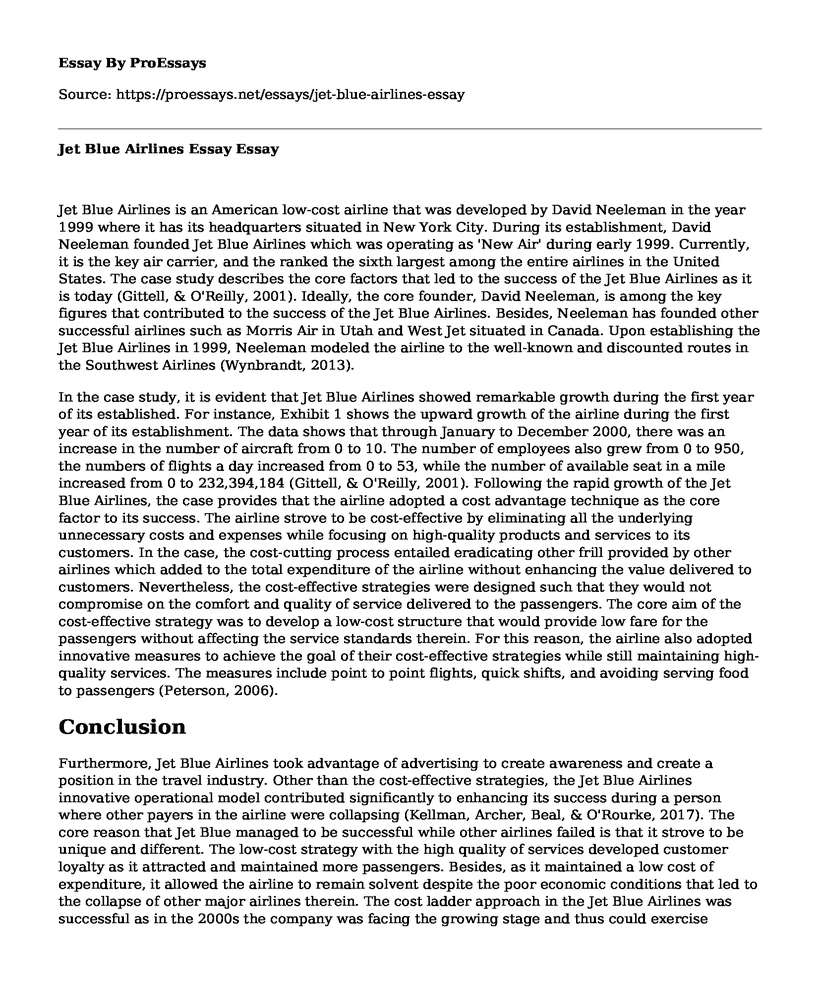Jet Blue Airlines is an American low-cost airline that was developed by David Neeleman in the year 1999 where it has its headquarters situated in New York City. During its establishment, David Neeleman founded Jet Blue Airlines which was operating as 'New Air' during early 1999. Currently, it is the key air carrier, and the ranked the sixth largest among the entire airlines in the United States. The case study describes the core factors that led to the success of the Jet Blue Airlines as it is today (Gittell, & O'Reilly, 2001). Ideally, the core founder, David Neeleman, is among the key figures that contributed to the success of the Jet Blue Airlines. Besides, Neeleman has founded other successful airlines such as Morris Air in Utah and West Jet situated in Canada. Upon establishing the Jet Blue Airlines in 1999, Neeleman modeled the airline to the well-known and discounted routes in the Southwest Airlines (Wynbrandt, 2013).
In the case study, it is evident that Jet Blue Airlines showed remarkable growth during the first year of its established. For instance, Exhibit 1 shows the upward growth of the airline during the first year of its establishment. The data shows that through January to December 2000, there was an increase in the number of aircraft from 0 to 10. The number of employees also grew from 0 to 950, the numbers of flights a day increased from 0 to 53, while the number of available seat in a mile increased from 0 to 232,394,184 (Gittell, & O'Reilly, 2001). Following the rapid growth of the Jet Blue Airlines, the case provides that the airline adopted a cost advantage technique as the core factor to its success. The airline strove to be cost-effective by eliminating all the underlying unnecessary costs and expenses while focusing on high-quality products and services to its customers. In the case, the cost-cutting process entailed eradicating other frill provided by other airlines which added to the total expenditure of the airline without enhancing the value delivered to customers. Nevertheless, the cost-effective strategies were designed such that they would not compromise on the comfort and quality of service delivered to the passengers. The core aim of the cost-effective strategy was to develop a low-cost structure that would provide low fare for the passengers without affecting the service standards therein. For this reason, the airline also adopted innovative measures to achieve the goal of their cost-effective strategies while still maintaining high-quality services. The measures include point to point flights, quick shifts, and avoiding serving food to passengers (Peterson, 2006).
Conclusion
Furthermore, Jet Blue Airlines took advantage of advertising to create awareness and create a position in the travel industry. Other than the cost-effective strategies, the Jet Blue Airlines innovative operational model contributed significantly to enhancing its success during a person where other payers in the airline were collapsing (Kellman, Archer, Beal, & O'Rourke, 2017). The core reason that Jet Blue managed to be successful while other airlines failed is that it strove to be unique and different. The low-cost strategy with the high quality of services developed customer loyalty as it attracted and maintained more passengers. Besides, as it maintained a low cost of expenditure, it allowed the airline to remain solvent despite the poor economic conditions that led to the collapse of other major airlines therein. The cost ladder approach in the Jet Blue Airlines was successful as in the 2000s the company was facing the growing stage and thus could exercise control over its operations. The ware no issues with labor as the airline was small enough to acquire, manage, and involve all the employees in the management process. Besides, Jet Blue operated in a niche market thus creating a competitive advantage over other airlines in the industry therein. For instance, despite adopting the southwest mode, Jet Blue did not function in the same markets.
References
Gittell, J., & O'Reilly, C. (2001). JetBlue Airways: Starting from Scratch. Boston, MA: Harvard Business School Pub.
Kellman, J., Archer, T., Beal, M., & O'Rourke, J. S. (2017). JetBlue: Competing for marketshare in a turbulent industry.
Peterson, B. S. (2006). Bluestreak: Inside JetBlue, the upstart that rocked an industry. New York, N.Y: Penguin Books.
Wynbrandt, J. (2013). Flying high: How jetblue founder and ceo david neeleman beats the competition ... even in the world's most turbulent industry. Hoboken, N.J: Wiley.
Cite this page
Jet Blue Airlines Essay. (2022, Jun 30). Retrieved from https://proessays.net/essays/jet-blue-airlines-essay
If you are the original author of this essay and no longer wish to have it published on the ProEssays website, please click below to request its removal:
- Strategic HR Planning: Key to Org Success & Customer Satisfaction - Essay Sample
- Paper Example on Airline Flight 1420: NTSB Report, Causes & Recommendations
- Achieving Goals with Management by Objectives: The Benefits to Organizations - Essay Sample
- Disruptive Tech: How It's Transforming Organizations & Consumers - Essay Sample
- Paper Example on Police Partners: React Appropriately for Successful Coordination
- Paper Example on CHRO Establishes Strategic Recruitment Plan for Expansion
- Essay Sample - Role of a Manager and Principles of Management







